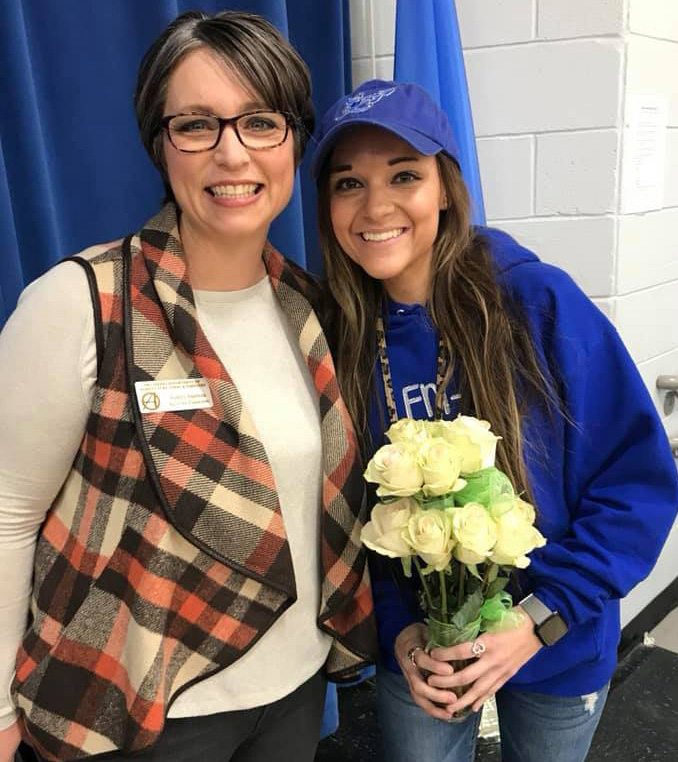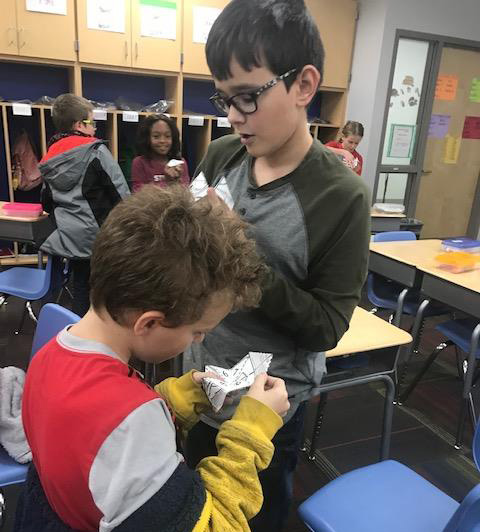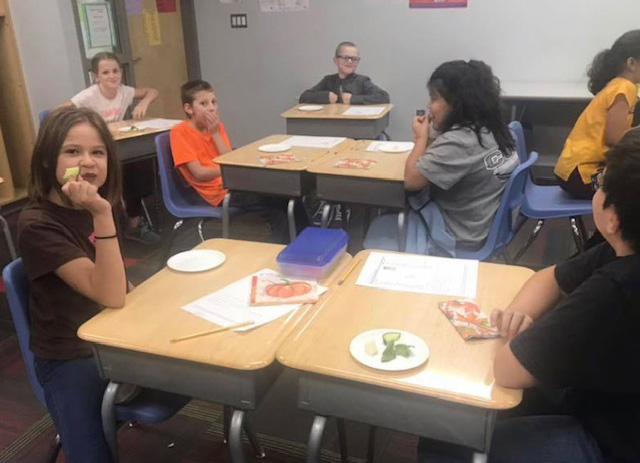Featured Teacher - May
Megan Plummer, Holmes Park Elementary, Sapulpa
2019 AITC Teacher of the Year, Elementary Finalist
Q1.
How did you first learn about the Ag in the Classroom Program?
 Megan: I was introduced to AITC in the summer of 2013 while working on completing the courses to obtain my teaching degree. This course opened my eyes to the many different ways that using Agriculture in the Classroom can boost a child's academic knowledge in a cross-curricular, and extremely engaging way. Even now, close to 5 years later, I have a picture saved of the potato person I made in this workshop. Since that time, I have continued to receive newsletter updates from AITC, as well as frequently visiting the website and using the lessons and useful links. I was also able to attend the Engage OK workshop: Fruits, Nuts, and Veggies, Oh My! When I saw that Ag in the Classroom would be presenting at Engage OK, I took that opportunity to share my experience with this program with my colleagues, and encouraged many to sign up to attend the presentation.
Megan: I was introduced to AITC in the summer of 2013 while working on completing the courses to obtain my teaching degree. This course opened my eyes to the many different ways that using Agriculture in the Classroom can boost a child's academic knowledge in a cross-curricular, and extremely engaging way. Even now, close to 5 years later, I have a picture saved of the potato person I made in this workshop. Since that time, I have continued to receive newsletter updates from AITC, as well as frequently visiting the website and using the lessons and useful links. I was also able to attend the Engage OK workshop: Fruits, Nuts, and Veggies, Oh My! When I saw that Ag in the Classroom would be presenting at Engage OK, I took that opportunity to share my experience with this program with my colleagues, and encouraged many to sign up to attend the presentation.Q2.
How do you incorporate AITC into your curriculum?
 Megan: I am always looking for ways to make my agricultural lessons cross curricular, hitting as many subjects as possible per lesson. Each of my lessons is extremely engrossed in enriched vocabulary, literacy, math, science, and social studies. The students vocabulary increases with agricultural topics, as well as many domain specific vocabulary words. We use agricultural literacy books that relate to our current topic, as well as any text or reading that goes along with and comes with the AITC lesson.
Megan: I am always looking for ways to make my agricultural lessons cross curricular, hitting as many subjects as possible per lesson. Each of my lessons is extremely engrossed in enriched vocabulary, literacy, math, science, and social studies. The students vocabulary increases with agricultural topics, as well as many domain specific vocabulary words. We use agricultural literacy books that relate to our current topic, as well as any text or reading that goes along with and comes with the AITC lesson.Calculations are made in many of our lessons, whether it be calculating distances food may travel, or calculating costs of making meals or running a farm. We use a lot of writing ideas to lead to discussion in small groups, and then as a class. The writing allows them to get their thoughts out prior to discussion. The reading literacy aspect comes through reading agricultural books, and text with the lessons. The math we use ranges from calculations to estimations and graphing. The graphing element can also be done as a whole group, which allows for the students to visually see the graph, as well as another opportunity to discuss with peers. This helps their speaking, listening, writing, reading, and math skills grow, all while learning more about agricultural concepts.
 When possible, I incorporate art and sometimes music, vocally, into my lessons. We have created commodity maps using art, and focusing on our county. Many students, when entering my room, could not tell you which county we were located in, now they can not only tell you what county we are located in, but they can also tell you the major commodities in our county! What a change to see take place! I believe tying in art to make it fun and colorful for the students was a big help in making this concept really stick in my classroom.
When possible, I incorporate art and sometimes music, vocally, into my lessons. We have created commodity maps using art, and focusing on our county. Many students, when entering my room, could not tell you which county we were located in, now they can not only tell you what county we are located in, but they can also tell you the major commodities in our county! What a change to see take place! I believe tying in art to make it fun and colorful for the students was a big help in making this concept really stick in my classroom.We also made fortune tellers when we discussed Turkeys. The art of folding paper was something all of my students were very interested in and excited to do. I had quite a few students return from Thanksgiving break with a story about taking their fortune tellers to a relatives house and quizzing them all with the turkey facts they were now equipped with. In telling me this, I could see that this gave them a sense of pride and joy in taking something they had learned, and teaching others.
In closing lessons, we always circle back to past lessons, as well as comparing and contrasting agricultural ideas between lessons and situations. A wonderful point to reach in these lessons is closure, this allows for students to see the relation and come to these conclusions themselves, with me only there as a guide and less of a teacher. To see the way they are able to communicate, think, and work together is an incredible thing. It is important for me to integrate real-life situations into my agricultural lessons so that the students can truly see the impact agriculture makes on their everyday life, while gaining skills they will need to be successful throughout their educational journey and into adulthood.
Q3.
What are other ways do you incorporate AITC lessons into your curriculum?
 Megan: Alongside the AITC curriculum and lessons, each year I use our local Nutrition Education curriculum. This is offered through the Oklahoma State University Extension Nutrition program. The nutritionist, Marie Gibbs, comes to my classroom and builds upon our past AITC lessons. This also allows for the students to hear another perspective on agricultural topics, and extends onto the health and well-being of the students themselves. Additionally, our school counselor has a worm farm of his own. Before the worms are introduced to my students, we begin by discussing soil and earth. When we are closer to wrapping up our lessons, he will bring in a worm bin for the students to see. Many are extremely surprised to see this in person, and many speak on the opportunity throughout the year as a fond memory.
Megan: Alongside the AITC curriculum and lessons, each year I use our local Nutrition Education curriculum. This is offered through the Oklahoma State University Extension Nutrition program. The nutritionist, Marie Gibbs, comes to my classroom and builds upon our past AITC lessons. This also allows for the students to hear another perspective on agricultural topics, and extends onto the health and well-being of the students themselves. Additionally, our school counselor has a worm farm of his own. Before the worms are introduced to my students, we begin by discussing soil and earth. When we are closer to wrapping up our lessons, he will bring in a worm bin for the students to see. Many are extremely surprised to see this in person, and many speak on the opportunity throughout the year as a fond memory.Q4.
What impact has AITC had on your classroom?
Megan: Many times, I believe that so many teachers are driven to be extremely focused on testing and testing achievement for students. Each year, it seems that teachers feel more and more stressed as test scores somehow become even more relevant. It causes many teachers to panic and feel they have no choice but to teach the standards exactly as they are listed on any testing blueprints or guides they may have. While this may make test scores go up, it does nothing for the student's overall growth or development to be a functional and aware citizen in their community and in the world. In using Ag in the Classroom, I believe I am able to touch on several standards, while still giving my students agricultural knowledge and information that they enjoy learning. I believe in this program, and know it has truly been a wonderful tool in my classroom.
Q5.
How have the AITC lessons impacted your students lives?
 Megan: Students are focused, truly engaged, and challenged by the inquiry based lessons and are excited to learn when we are using and working with Ag in the Classroom lessons.Using AITC in my classroom has been a game changing experience. The majority of my students have never had any experiences outside of our small, suburban city. In the past 5 years, I have never had a student come into my classroom with any understanding of agriculture, or agricultural aspects. I always encourage my students to go home and discuss with siblings, parents, or guardians they things they have learned. They are always eager to go home and share new information with their families when it comes to agriculture.
Megan: Students are focused, truly engaged, and challenged by the inquiry based lessons and are excited to learn when we are using and working with Ag in the Classroom lessons.Using AITC in my classroom has been a game changing experience. The majority of my students have never had any experiences outside of our small, suburban city. In the past 5 years, I have never had a student come into my classroom with any understanding of agriculture, or agricultural aspects. I always encourage my students to go home and discuss with siblings, parents, or guardians they things they have learned. They are always eager to go home and share new information with their families when it comes to agriculture.In my classroom, I use many of the lessons that will allow my students greater opportunities, or opportunities they may not otherwise have. One of the lessons my students truly enjoy is, "Be a Food Explorer." This lesson is always an eye opener to me, and a wonderful experience in my classroom. Most of the students in my classroom have very little idea of where food comes from. They are always wanting to learn more and more about the origin of fruits and vegetables because the idea of the distance traveled is unheard of to the majority of the students in my classroom.
Q6.
What advice do you have for other teachers to use AITC in their classrooms?
Megan: When using AITC lessons, I choose lessons that I can link to one another so that the students can make connections, and have authentic discussions on agricultural topics. They enjoy sharing thoughts and ideas during this time, and it also gives them the opportunity to hear and think on others opinions and experiences. This is a skill that is always helpful in school, and as an adult in everyday life.
